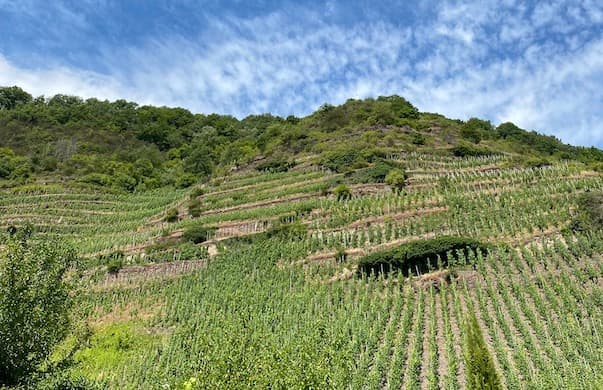Germany Looks To Be Entering Its Second Golden Age of Wine
Grapes for wines have been grown in that country since the time of the Roman empire, and these 2,000 years have led to a land entrenched in history, traditions, and know-how.

A recent whirlwind trip to the major wine regions in Germany has this writer reflecting on the country’s past and its future. Germany has been growing grapes for wines since the time of the Roman empire, and these 2,000 years have led to a land entrenched in history, traditions, and know-how.
As part of northern Europe, the vineyards were historically at the latitudinal edge of viable viticulture. They were planted to capture the maximum amount of sunlight throughout the short growing season in an attempt to fully ripen grapes. This meant utilizing steep hillsides with southerly exposures to harness the maximum amount of heat and light, and usually planting along rivers to capture even the reflective rays of the waters’ surface. For centuries along the Mosel and Rhine rivers one would have seen every available south-facing plot covered in vines.
The Golden Age of German wine started in the mid-1800s. Riesling was king: a delicious, semi-aromatic white grape capable of producing the greatest range of styles of any wine — bone dry to unctuously sweet, still or sparkling. Thanks to its naturally high acidity and propensity to sugar accumulation, it’s also exceptionally age worthy. Restaurant lists from the 18th and early 19th centuries featured German wines at higher prices than wines from anywhere else, including Burgundy, Bordeaux, and Champagne.
Two world wars changed all that. The laborious work needed to care for these sites was redirected toward the battlefield. Afterward, a global shunning of all things German, along with an extensive depression and a lack of manpower, led to the long, slow decline of these once great vineyards. With limited resources, Germans focused on high-yielding varieties like Muller Thurgau on the easy to work, but qualitatively inferior, flat vineyards. Export markets were then flooded with cheap, sweetish plonk and the reputation of the wines fell even further.
For nine years I’ve been learning about and selling German wine, with a more focused approach the last four. The trajectory the market has taken here in the U.S. during such a short window has been fascinating. What was one of the most underpriced, underappreciated, and misunderstood categories of wine in the U.S. is now coming back online with such force one wonders if we are entering our second “golden age.”
A few reasons why come to mind. One is the rapidly increasing price and demand, often coupled with decreased supply from other traditional and classic wine regions, like Burgundy and now Champagne. Wine lovers are looking for alternative, European-styled wines that they can afford. German wines fit the bill.
Second is climate change. Until the 1990s, the climate in Germany was so precarious that one could predict two terrible, seven mediocre, and only one great vintage every decade. Now, instead of chasing ripeness, the rising temperatures mean acid retention is more often the goal. There has been a string of great vintages, with many considered exceptional, over the last three decades. The last truly atrocious year was 1987.
Third is a change of perception or a change in tastes. Climate change has warmed up every wine region. This has been a boon to those in marginal zones, like Germany and Champagne, where consistent ripening is now possible. Consumers are prizing the colder, more “classic” vintages with higher acidity and lower alcohol levels. Now, a cold German vintage like 2021, which would have been labeled as “too austere” for those focused on sugar ripeness, is being touted as possibly the last great classic vintage in Germany. There is a wave of folks rushing to embrace this quickly disappearing style.
Fourth is a millennial generation-themed “search for the authentic.” This puts a premium on the historical nature of sites that have been kept in production or revived. There are younger generations who are less acutely influenced by Germany’s dark past and instead are looking to hold on to these places that have been nearly forgotten — and they are willing to pay for it.
Driving through the vineyards of Germany, one is continuously struck by two extremes: How death-defyingly steep many of the vineyards are, and the thousands of ancient hillsides and once-prized plots that have been abandoned. These are vineyards once farmed by Romans and their juices drunk by the kings of Europe. One can only hope this quickly turning tide is fast enough to keep these vines and wines in production for people to enjoy for another 2,000 years.

